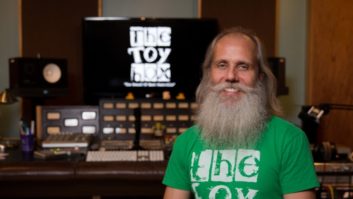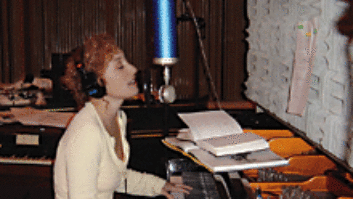Nashville-based music author Jake Brown has made something of a cottage industry for himself with his In The Studio series of artist biography/working profiles; the latest, Tori Amos: In The Studio, takes a look at the title songstress and the creation of her prolific discography.
While much of the book’s insight comes from secondary sources (we’re talking a comprehensive 16-page bibliography here), Brown lands some intriguing interviews with people involved in Amos’ artistic process, including Eric Rosse, producer of her breakthrough Little Earthquakes album, and Joe Chiccarelli, who produced her now-obscure debut, Y Kant Tori Read.
While both producers convey some of the stories behind their respective albums, they also reveal a bit of the gear they had on hand to help capture the moment. Rosse recounts taking over the reigns on Little Earthquakes after initial recordings with a different producer were scrapped.
“We did those songs so on the cheap and I had a little studio in a little guest house out in L.A. I had this old 3M twenty-four track analog tape machine, a tiny little modified, very compact console made by Allen & Heath, and it was just what we had to work with at the time. And a Yamaha CP80 piano which we miked with a combination of a modified 414, which is not the mic I would use today, but again, back then it was the only mic I had. And I think a couple of times, we rented a Telefunken 251.
“We only had a budget of $6,000, so we had tremendous limitations we had to work within, which I think is part of what drove the creative process, and drove some of the inventiveness of the recording process. It was a labor of love, and a love of labor to do that. Especially at the time, it was all analog recording, and samplers were still pretty basic, so if you were working a really tight budget, it wasn’t easy to do things as it is now. We had literally no money to do these extra tracks; it was really hysterical, we were recording guitar amps in a closet.”
More interesting, however, is the behind-the-scenes look at Amos’ debut, Y Kant Tori Read. A critical and commercial flop (7,000 copies sold, which today makes it a Holy Grail relic for her fans), the intricate album was quickly dismissed, in part because of its “rock-chick” cover that found Amos in full-on, late ’80s Big Hair mode, wearing pirate regalia and brandishing a sword.
While Amos alternately derides and defends the album in its chapter, she is quoted as saying the experience taught her “…a lot of simple fundamentals that you apply when you’re in a producer situation. And that was a gift. Like, never do a take with the band right after they’ve eaten; don’t do punch-ins because the tempo’s going to slow down; or, if you’re doing a substance, stick with that substance ’til you’ve done the overdubs!”
For many, Amos’ vocals are the key ingredient of her songs; Chiccarelli recalled capturing them on that first album:
“When Tori was tracking vocals, some songs went very quick, but on others, I remember she really took direction well with the vocals, and really wanted to work hard. And with her, it was always about delivering the right emotional performance. An exotic thing we did on the record was with Tori’s vocal mic. We were trying out a lot of different vocal mics for Tori, and things like a Telefunken 251 and brighter, airier mics sounded good on her. But we happened to come across this Swedish mic called a MiLab VIP-50, and I think somebody had loaned it to me to check out. But when I tried it on Tori, it really sounded great, so we used that on the majority of the album’s vocal tracks.”
…And despite the album’s poor reception, Chiccarelli still has a warm place for it in his heart, finding it to be a personal milestone in his career:
“My favorite moment in the whole making of the record was, when the album was done and mixed – maybe a week or two later – Tori called me up and said, ‘You know, I love my album, this is exactly what I wanted. I really love this album, I’m so proud of it. Thank you so much for making the record I wanted. This is who I am,’ so that was one of the most rewarding moments of my career. Whether or not the record was a commercial success or flop—it didn’t matter to me. The fact that I was able to help her make the record that she had in her head—that’s what a producer’s job is, and I’m proud that I was able to achieve what she wanted for her first record.”
Insights like these also come throughout the book from the likes of Marcel van Limbeek and Matt Chamberlain, engineer and drummer respectively on all her albums from From The Choirgirl Hotel to 2009’s Midwinter Graces. Tailored for fan and studio enthusiast alike, Brown’s book provides a unique and surprisingly fact-oriented look into the career of a famously nebulous artist.
Tori Amos: In The Studio on Amazon
http://amzn.to/l9YEhE





